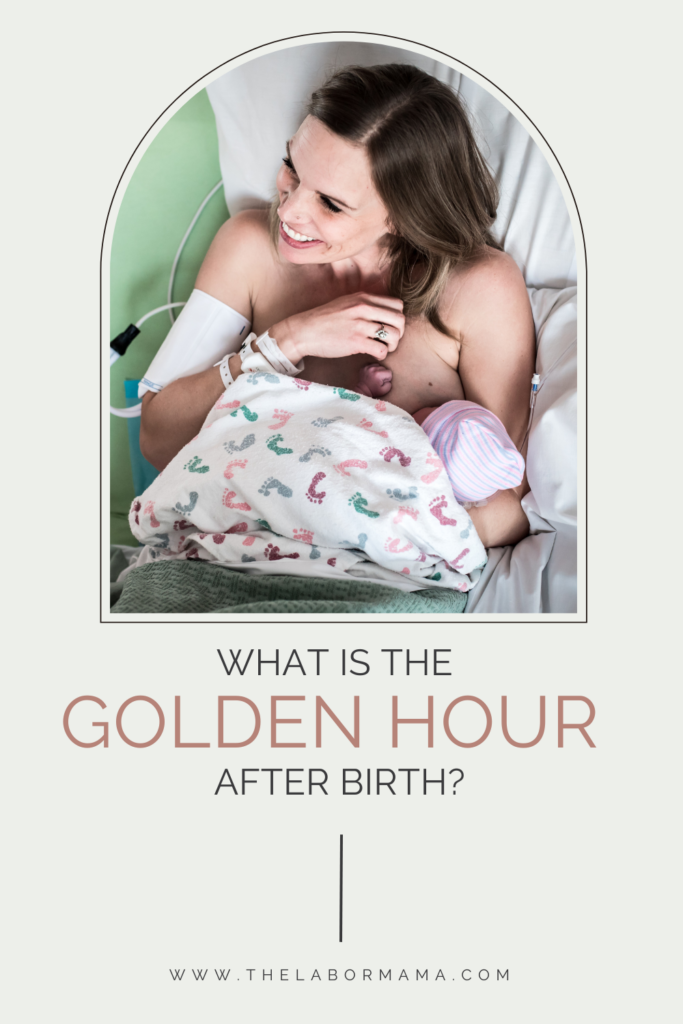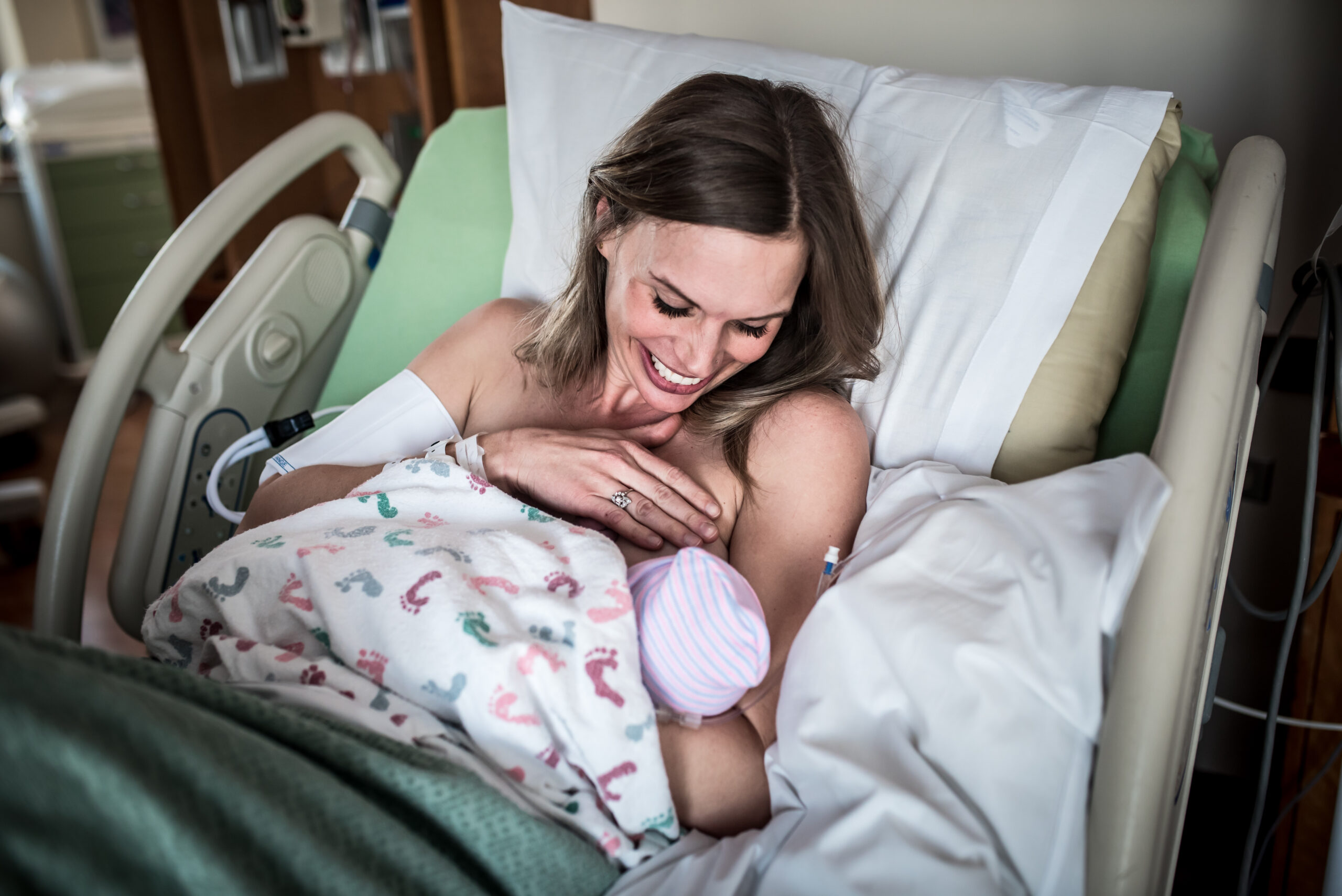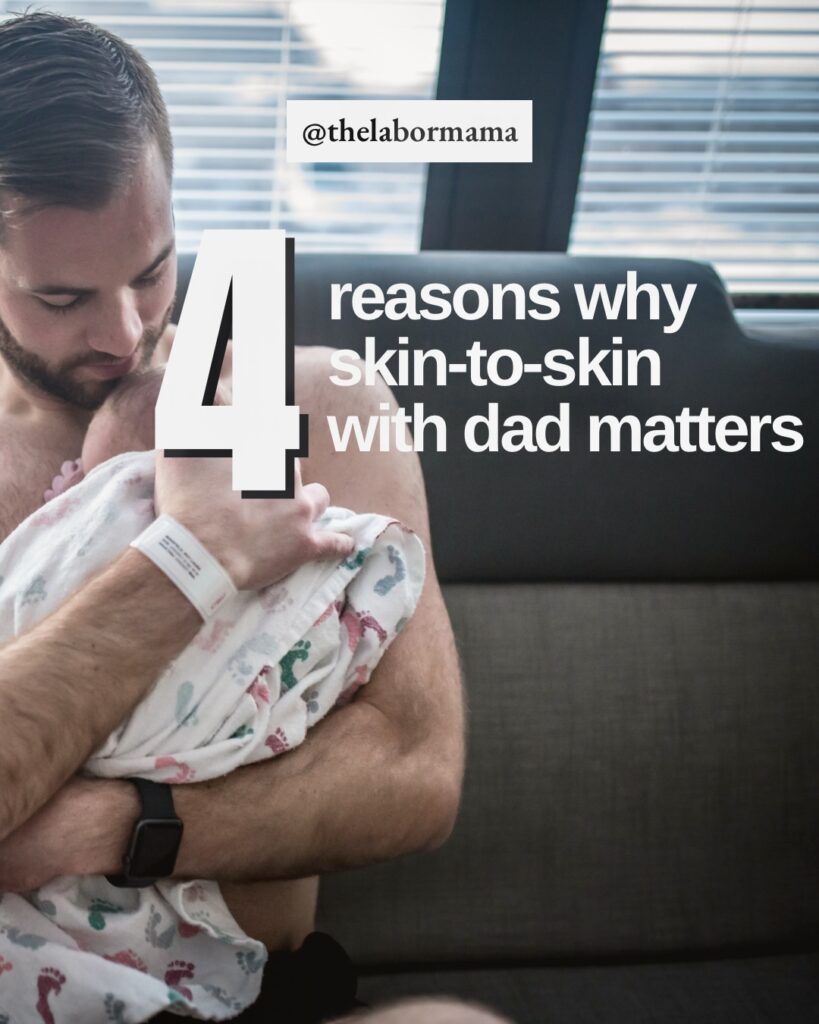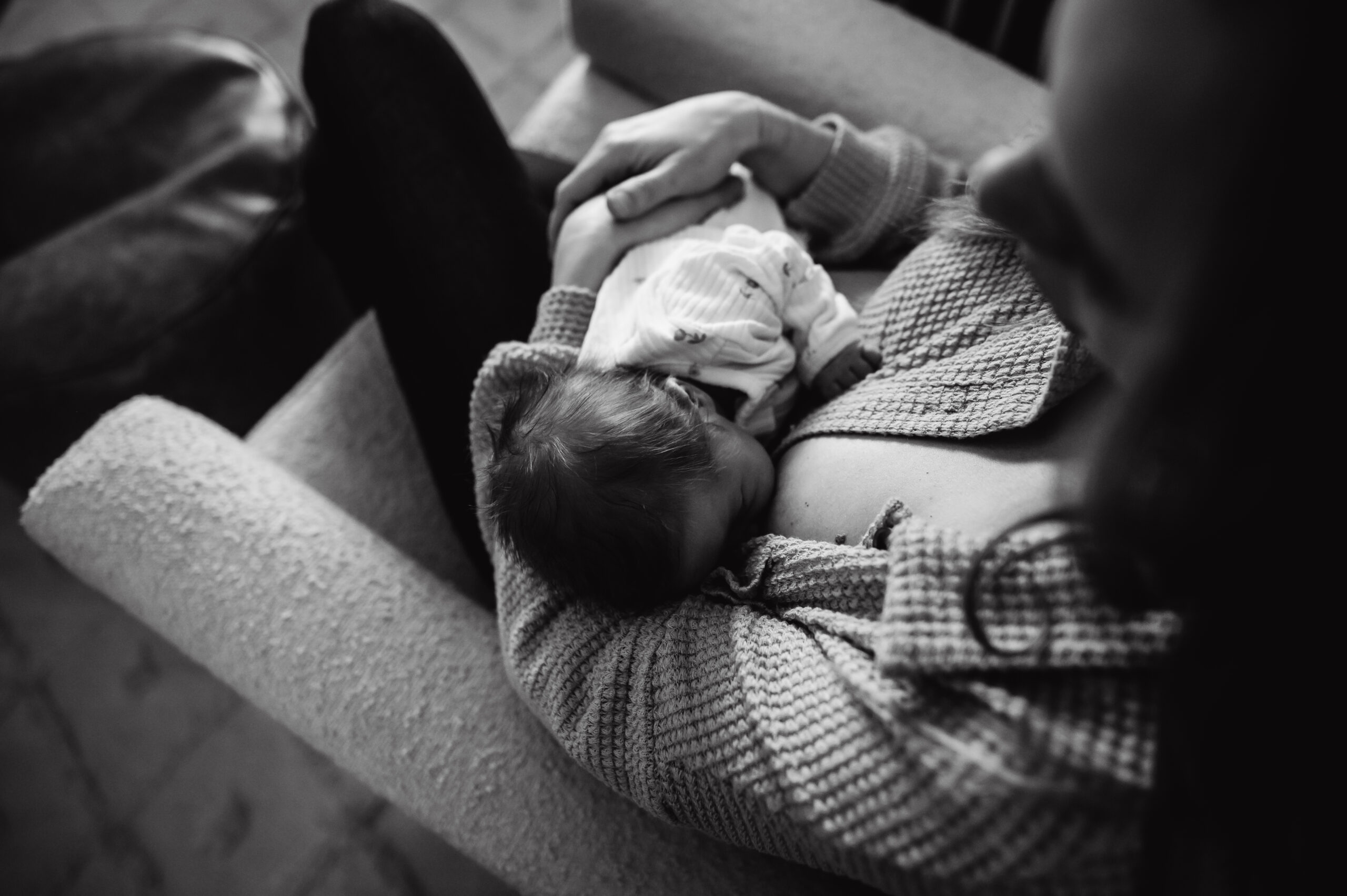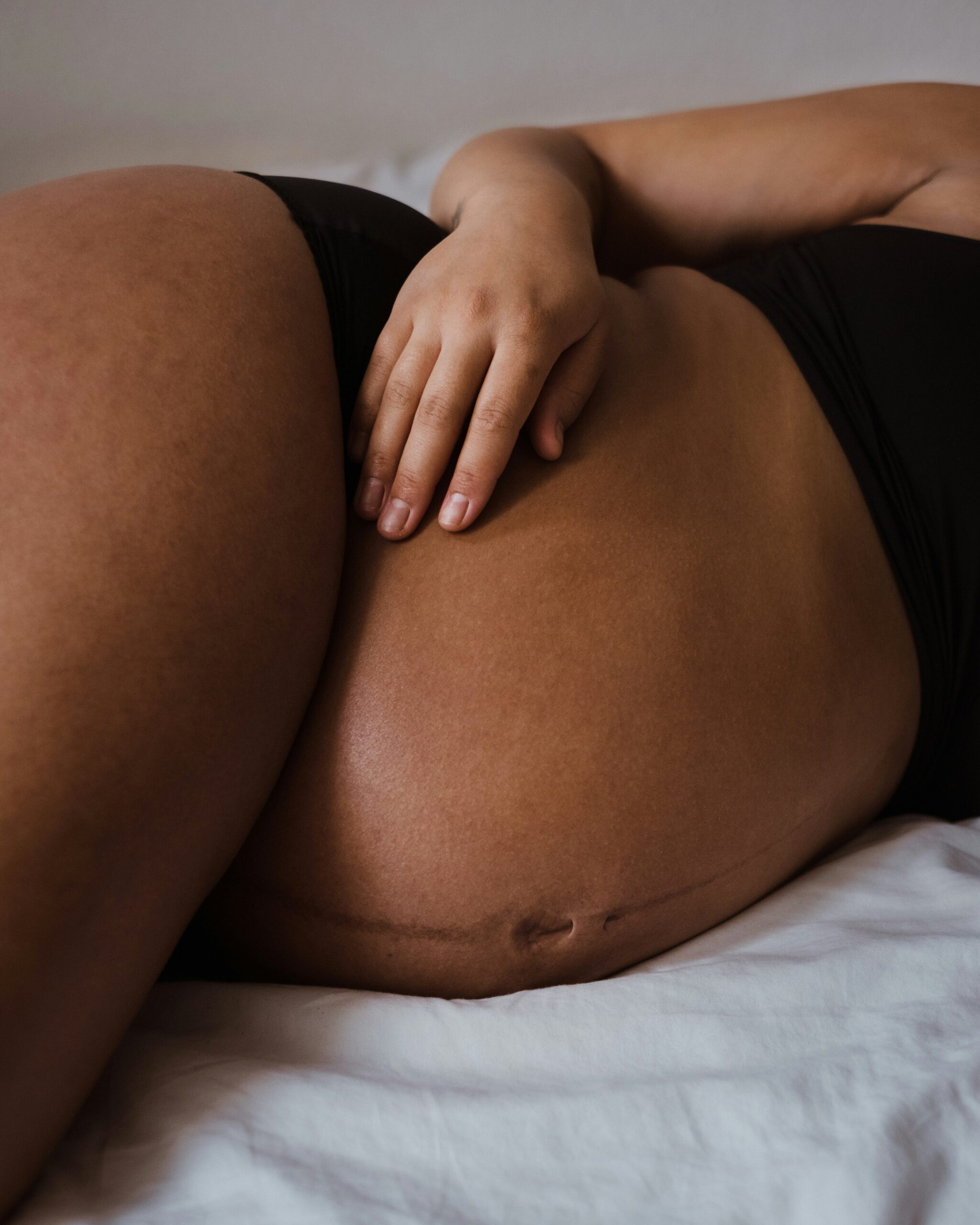Let’s talk about the golden hour after birth! This 60 minutes (or more) ideally occurs immediately after birth. This hour or two is both yours and baby’s “transition” time; the hours are commonly referred to as the “fourth stage of labor.” At most birthing facilities, your baby is under the care of a nursery RN during all of this. Both that RN and your RN will be moving in and out of the room to keep an eye on both of you. As a mama, let me tell you that these minutes can be such an exciting, up and down, blur. It is all unforgettable, but it can also go so, so quickly!
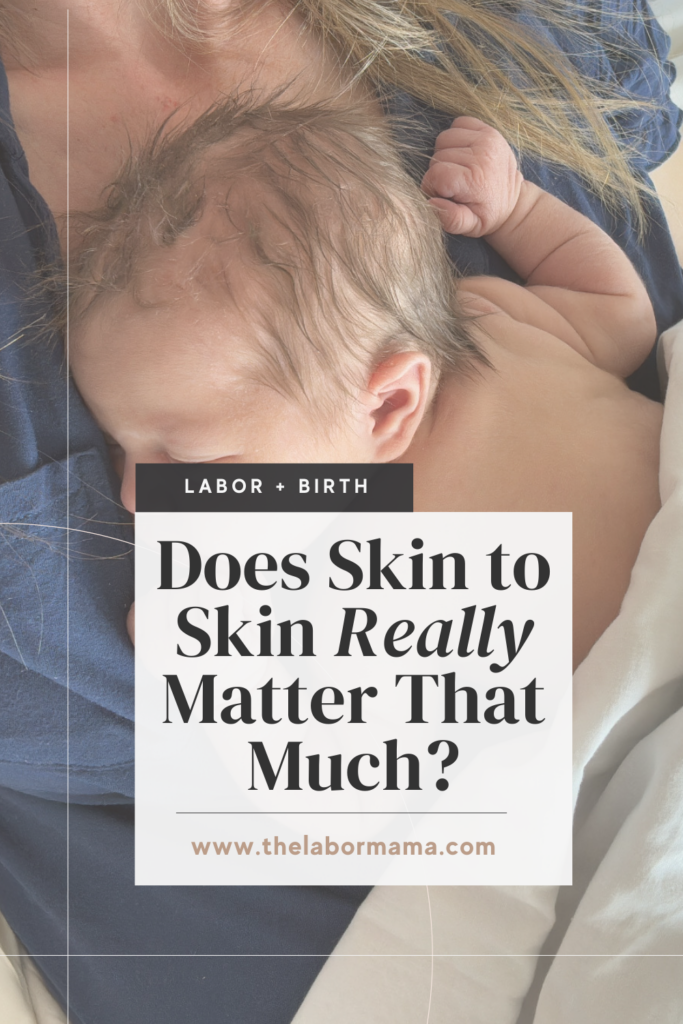
Before we go much deeper into the golden hour and the benefits of skin to skin – Who is The Labor Mama and Why Am I Here?
Hey friend! I’m Lo – also known around here and social media as The Labor Mama. I’ve spent my nursing career in labor, delivery, and postpartum, have birthed 4 of my own babies, have labored thousands of mamas at the bedside, have taught thousands of students online, and have even delivered a few speedy little babies with my bare hands (oops).
Here at TLM, I offer online classes about birth, postpartum, newborn care, and breastfeeding to empower you the way everyone should be. The education + support I offer gives you experience, evidence, and empathy; you’re getting all of my years of “clinical” RN knowledge, honestly combined with my real experiences as a mama and a nurse. These are not your average hospital classes (those won’t do it, I promise), and honestly, birth, postpartum, and breastfeeding don’t follow a textbook or protocol anyway. You need to know so much more than that!
If you want to connect with me further, head to Instagram. There are hundreds of thousands of us over there learning together daily.
A note: This post may include affiliate links. This means if you make a purchase after clicking a link, I will earn a small commission (thank you)! Rest assured, this comes at no additional cost to you. You can read TLM’s full disclosure here.
What is the golden hour after birth?
Ideally, every baby is able to go straight to their delivering mother’s chest after birth. They are placed skin-to-skin on the maternal chest and covered in warm blankets. Baby then gets to stay there, uninterrupted. At some point, the first feed is done as well.
When this time can happen, it kicks off what is commonly referred to as ‘The Golden Hour’ after birth. Research about this time shows that the full hormonal benefits of skin-to-skin are best achieved when that 60 minutes of time is uninterrupted. Unless a medical need comes up with the baby that demands they leave your chest, both the baby’s RN and your RN can do their jobs while you hold your baby. All other non-emergency care can be delayed until after this time is over.

Why is the golden hour after birth important?
The golden hour actually has some incredible benefits (and you know I love my research)! It’s kind of wild to me all that this time together can potentially do.
Benefits of the golden hour
- Reduction of stress: When a baby is placed skin-to-skin, it can actually slow the mother’s production of adrenaline. This is great, because adrenaline can interfere with oxytocin and prolactin; they are essential components of breastfeeding and bonding. Babies also show decreased stress hormones.
- Skin to skin regulates baby’s body systems: Skin-to-skin helps babies regulate their body temperature – which can be a bit tough to keep high after birth – and it can lower their risk of low blood sugar levels.
- Enhances baby’s immune function: Exposure to mama, both in the birth canal and during skin-to-skin, helps baby “learn” about good and bad bacteria. This can enhance both their skin AND gut microbiome. Essentially, their immune system gets kicked on and starts learning right away.
- Promotion of bonding: All mamas actually have MORE oxytocin receptors on their brain after pregnancy – skin-to-skin causes oxytocin to be produced – and your brain is super receptive to this love hormone and all the bonding it can encourage.
- Initiation of breastfeeding: For those desiring to breastfeed, skin-to-skin is linked to more successful rates of breastfeeding initiation and duration.
The golden hour and breastfeeding
You just saw on that list that the golden hour has some good benefits that relate to breastfeeding. Let’s discuss those a bit more. The act of breastfeeding causes oxytocin to be released in the maternal body. Oxytocin is important to bonding and it helps the uterus contract. We want this after birth, as it’s a big part of preventing postpartum hemorrhage. Research also shows that mother/baby couplets that get the golden hour after birth are more successful at beginning the breastfeeding process. This golden hour time can also lead to a longer breastfeeding relationship overall.
What is colostrum?
When babies are able to latch well and breastfeed in this time, they also get instant access to colostrum. That is the thick, sticky, (often) yellowish liquid that is the “first milk” your body makes. It is small in volume and often just comes out in drops. You may actually have leaked some during pregnancy; some also decide to do antenatal colostrum collection.
Here are some cool benefits of that nutrient-rich colostrum:
- strengthens baby’s immune system, helping it learn to fight off infections and destroy bacteria and viruses
- helps the baby pass the first stool (meconium)
- reduces risk of jaundice (when baby’s bilirubin levels get too high)
- supports GI healthy by protecting baby’s stomach and intestines from diseases and infections
A note: If you peek back at that list of potential benefits of the golden hour after birth, you can see that many of them aren’t related to breastfeeding. Even if you do not desire to breastfeed, I would encourage you to still take this time and let baby (and you) receive all the other benefits.
What if I do not get the golden hour with my baby?
I think it’s really important that I pause here and address those who may not get to do the golden hour. Perhaps your baby is in the NICU, you’re too groggy from unexpected anesthesia or magnesium, or you experience a postpartum hemorrhage. There are reasons skin-to-skin can’t happen – and I do NOT want you to feel any guilt about this. Not getting to do skin-to-skin immediately does not mean all of these benefits are lost! It also does not mean breastfeeding will fail, that their immune system is depleted, etc. The practice of skin-to-skin maintains many wonderful benefits throughout the first year – so please, do it when you are able and then continue to do so! If you need to, grieve not getting this if you really wanted it – I understand that completely. But do not feel guilt or shame about it – okay?
Should my partner do skin-to-skin?
If you are unable to practice skin-to-skin at birth, did you know that your birth partner can do it? Not all of the benefits will happen on their chest, but many still do. Research related to fathers and skin-to-skin time after birth shows these benefits:
- Decreases baby’s cortisol (stress levels)
- Supports mature sleep cycling
- Enhances immune system via exposure to that chest
- Decreases cortisol and somatostatin (this can allow baby to absorb and digest nutrients better and support weight gain)
- Regulation of baby’s body temperature (*Dad’s body can warm, but it cannot cool baby as mama’s could)
- Regulation of heart rate and breathing
- Baby more “awake”/quicker to breastfeed
- Increases psychosocial well being (hello oxytocin) for Dad – affection, nurturing, confidence, bonding – and possibly decreases rates of paternal postpartum depression and leads to stronger attachment
We need more research on the topic of dads and partners and this time after birth. But, the research that exists right now indicates that your baby getting time on both/either parent’s chest is really valuable. Also, don’t forget that this isn’t an either/or situation. If you can, do your time in skin-to-skin time and then have your partner do theirs too before you move on to whatever is next.
The takeaway on the golden hour after birth
The golden hour is a precious time together for a lot of different reasons. Most birthing facilities are going to offer and support this time. If yours does not, now you know that you have lots of evidence to support advocating for it! If you are having a cesarean birth, this time can occur in the operating room. This is part of what is called a ‘gentle cesarean‘ or a ‘family-centered cesarean.’ If your facility does not allow for skin to skin in the OR, then you may want to consider asking your partner to spend this time with baby until you are able. Lastly, if you (or a partner) do not get this time right away, know that skin-to-skin benefits do not disappear after the first hours! As long as you and baby enjoy the time together, skin-to-skin can continue to be beneficial throughout the first year.
Looking for some other ways to get labor started? Here’s some other posts you’ll probably like:
- Eating Dates Might Help Your Labor: Here’s Why
- Midwives Brew: Should You Try This Natural Induction Method
- What is a Membrane Sweep and Should You Try One?
- The Miles Circuit: Can It Induce Labor?
- What Actually Makes Labor Start?
More resources (and freebies!) for you to take a peek at:
- Comprehensive Birth Plan and Birth Priorities templates
- A complete Third Trimester Checklist
- The RN + mama of 4 Ultimate Packing List
- The Labor Mama online birth, baby and breastfeeding classes for every family
